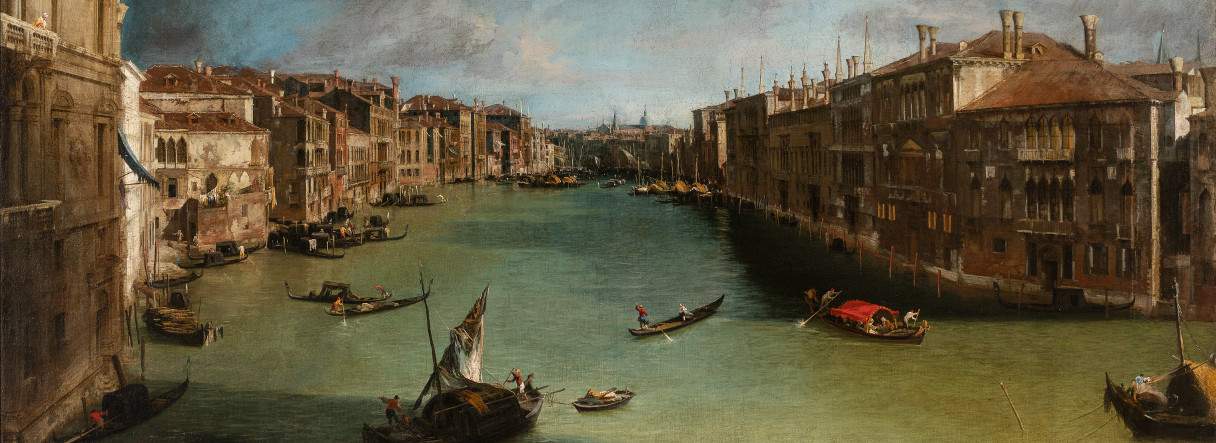A major exhibition in Venice on Canaletto and 18th century Venice from Tiepolo to Rosalba Carriera
From February 23 to June 9, 2019, Venice will host, in the Doge’sApartment of the Doge’s Palace, the exhibition Canaletto and Venice, an in-depth study that, starting from the great protagonist of the Venetian eighteenth century, Giovanni Antonio Canal known as Canaletto (Venice, 1697 - 1768), intends to evoke a century of lights and shadows, an artistic season of great complexity and value, of vitality and profound changes for the city and its social life, as well as for its art, amid innovations in ideas and techniques.
The exhibition, curated by Alberto Craievich with the collaboration of RMN - Grand Palais (Paris), starts from the new artistic forms that break the ties with the rigor of classicism and the theatricality of the Baroque, causing color to take over from drawing. Luca Carlevarijs (Udine, 1663 - Venice, 1730) laid the foundations of Venetianvedutismo, Rosalba Carrera (Venice, 1675 - 1757) with her delicate pastel compositions renewed the art of portraiture, and two young contemporaries painted works in which light acquired foundational, constitutive value: they are Giambattista Tiepolo (Venice, 1696 - Madrid, 1770), who created his dynamic compositions with aggressive brushstrokes, and Canaletto, who proposed view painting. The style of both will later become more controlled and sharp.
The journey continues with the costume painting of Pietro Longhi (Venice, 1701 - 1785), the explosion of vedutismo, history and landscape painting, and capriccio. And the great season of engraving, which several experimented with, and of Giambattista Piranesi (Mogliano Veneto, 1720 - Venice, 1778). The narrative of this century is also that of the European presence of the Serenissima and the travel of its artists. While Murano’s glass art also experiences its glories, with goldsmithing and porcelain manufacture. Protagonists at the end of the century were Francesco Guardi (Venice, 1712 - 1793) and Giandomenico Tiepolo (Venice, 1727 - 1804), son of Giambattista. In Guardi’s views, the flickering and allusive pictorial language, far from the sunny certainties of Canaletto, seems to evoke a decaying Venice, as the time of happy and aristocratic living gives way to a people of irreverent Punchinellos, where all are free and equal, and in the background the revolution inflames France. The Age of Enlightenment, and with it the exhibition itinerary, closes with the rise of Neoclassicism: the figure of Antonio Canova (Possano, 1757 - Rome, 1822) towers above them all.
The exhibition can be visited during the opening hours of the Ducal Palace. Until March 31, daily from 8:30 a.m. to 5:30 p.m. (last entry at 4:30 p.m.), from April 1 from 8:30 a.m. to 7:30 p.m. (last entry at 6 p.m.). Tickets for the exhibition can be purchased until Feb. 22 at the special price of 8 euros. For all info and to purchase tickets, you can visit the appropriate section on the Doge’s Palace website.
Image: Canaletto, The Grand Canal from Palazzo Balbi to the Rialto Bridge, detail (c. 1723; oil on canvas, 144 x 207 cm; Venice, Ca’ Rezzonico, Museo del Settecento veneziano)
 |
| A major exhibition in Venice on Canaletto and 18th century Venice from Tiepolo to Rosalba Carriera |
Warning: the translation into English of the original Italian article was created using automatic tools. We undertake to review all articles, but we do not guarantee the total absence of inaccuracies in the translation due to the program. You can find the original by clicking on the ITA button. If you find any mistake,please contact us.





























